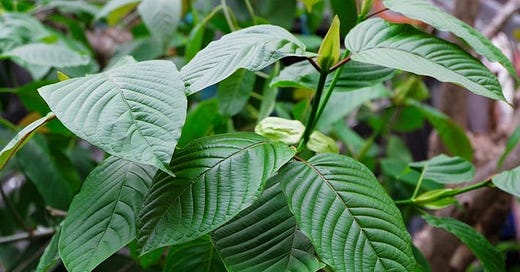Introduction to Kratom: Use, Dependence, and Withdrawal
DISCLAIMER
The content provided in this Substack post is for entertainment and informational purposes only and is not intended to serve as medical advice. The views and opinions expressed herein are those of the writer and should not be taken as definitive or authoritative. Readers should not rely solely on the information provided in this post to make decisions about patient care. Instead, use this content as a starting point for further research and consult a qualified healthcare professional before making any changes to treatment or medication regimens.
Today’s post will focus on a natural substance of abuse… Kratom. Perhaps you have heard of it. Perhaps not. By the end of this post you will be familiar with what it is, how it works, what dependence looks like, how to manage withdrawal & it’s potential to interact with CYP450 enzymes. Enjoy!
What is Kratom?
Kratom, or Mitragyna speciosa, is a tropical tree native to Southeast Asia. Its leaves contain compounds that have psychotropic effects. Per the FDA: “kratom is not lawfully marketed in the U.S. as a drug product, a dietary supplement, or a food additive in conventional food.” Although this is the case, it has been quite simple to and has been easy to order on the internet in various forms – capsules, powders, or leaves for brewing tea or for smoking. Quite literally, with a simple 30 second google search you can find a website that will deliver kratom directly to your door. With that said…. let’s move on.
How does it work:
While it’s mechanism is not fully understood, there are some things we do know relatively well which will be broken down further below.
1. Opioid Receptor Activation:
The primary active compounds in kratom, mitragynine and 7-hydroxymitragynine, are known to act as partial agonists at the μ-opioid receptors (mu-opioid receptors) and antagonists at the κ-opioid (kappa-opioid) and δ-opioid (delta-opioid) receptors.
As partial agonists, these compounds activate the μ-opioid receptors in the brain, but to a lesser extent than full agonists like morphine. This is believed to be a major part of kratom's analgesic (pain-relieving) effects.
The antagonist effects at other opioid receptors are less well understood but might contribute to kratom's complex effects.
2. Effects on Neurotransmitter Systems:
Mitragynine is also thought to have effects on other neurotransmitter systems in the brain, including serotonergic, dopaminergic, and adrenergic pathways. For example, it may act as a serotonin and norepinephrine reuptake inhibitor, which could contribute to mood-lifting effects.
Keep reading with a 7-day free trial
Subscribe to Short Bits for Inquisitive PMHNP's to keep reading this post and get 7 days of free access to the full post archives.




